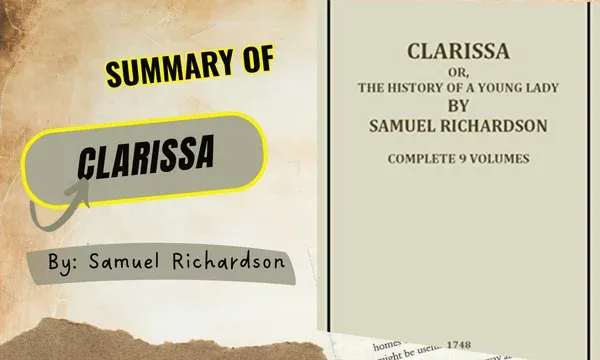Clarissa by Samuel Richardson is a novel that explores the themes of virtue, social class, morality, and the consequences of one's choices in 18th-century English society.
 |
| Summary of Clarissa by Samuel Richardson |
The general idea of Clarissa's book
Virtue vs. Vice: The novel presents a dichotomy between Clarissa Harlowe, a virtuous and morally upright young woman, and Robert Lovelace, a manipulative libertine. Their contrasting choices highlight the battle between virtue and vice.
Social Class and Gender: The book delves into the constraints of social class and gender roles. Clarissa's struggle against her family's desire for an advantageous marriage illustrates societal expectations and pressures.
Individual Autonomy: Clarissa's pursuit of autonomy in choosing her own destiny is central to the narrative. Her struggle against external control reflects broader societal shifts toward individual agency.
Clarissa book chapters
Volume 1: Letters 1-22: Introduces the Harlowe family and their attempts to control Clarissa's marriage to the wealthy but undesirable Mr. Solmes.
Volume 2: Letters 23-66: Clarissa's growing resistance to her family's plans and her correspondence with Anna Howe, her confidante.
Volume 3: Letters 67-149: Clarissa's tragic abduction by Robert Lovelace and her subsequent struggles against his manipulation.
Volume 4: Letters 150-211: Intensification of Clarissa's conflict with Lovelace, leading to her tragic fate.
Clarissa's book conclusions
The novel underscores the consequences of societal norms and parental control on individual lives.
Virtue is portrayed as a complex attribute, tested and often misunderstood in a morally ambiguous world.
The tragic outcome serves as a cautionary tale about the dangers of unchecked desires and the importance of ethical choices.
About the author of Clarissa
Samuel Richardson (1689-1761) was an English writer and printer. His background in letter-writing and his understanding of interpersonal dynamics contributed to his skillful use of letters as a narrative device in "Clarissa."
Clarissa's book audience
"Clarissa" was intended for a middle-class readership of the 18th century interested in exploring societal norms, morality, and the struggles of women in a patriarchal society.
Reception or Critical Response to the Book
"Clarissa" garnered significant attention for its innovative use of epistolary form and its exploration of complex emotional and moral dilemmas. While praised for its depth, it also faced criticism for its length and perceived sentimentality.
Clarissa's book publication date
"Clarissa" was first published in 1747 by Samuel Richardson himself, using his own printing press.
Recommendations for other books
"Pamela" by Samuel Richardson: Richardson's earlier work that also examines themes of virtue and morality in the context of a young woman's struggles.
"Dangerous Liaisons" by Pierre Choderlos de Laclos: A French novel exploring similar themes of seduction, virtue, and manipulation.
"Clarissa" serves as a cautionary tale, spotlighting the clashes between virtue and vice, the constraints of social norms, and the tragic consequences of unbridled desires in 18th-century English society.
